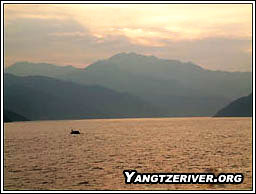Three Gorges
Qutang Gorge
Qutang Gorge is the shortest part of the Three Gorges (8 kilometers). It is considered the most dramatic. The river navigates through the gorge's sheer, steep cliffs where the Meng Liang staircase from the Song Dynasty can be seen. It starts at the White Emperor City in the west and ending at Daxi Stream in the east with a distance of 8 kilometers.
Here the width of the river is reduced to 100-200 meters and the narrowest places are no more than a few dozen metros while the principal peaks on the banks are as high as 1,000-1,500 meters. The turbulent waters flowing in the deep gorge along a continuous line of peaks make a most magnificent picture. The rolling and roaring river bursts through the rock gate that towers over the water.
Wu Gorge
Wu Gorge extends from the mouth of the Daning River in Wushan County, Chongqing City in the west to Guandukou in Badong County, Hubei Province in the east. Wu Gorge 44 kilometers long. The gorge is known for its deep valleys and forest covered mountains. Wu Gorge is a long and neat gorge divided into two sections - the Golden Helmet and Silver Armor Gorge and the Iron Coffin Gorge.
Wu Gorge is full of zigzags, weird peaks, rising mists and beautiful sights. As the river cut through the WushanMountains, its roaring currents change their directions constantly. Travelling through the gorge in a boat, one sometimes may find the way blocked by mountains. But a sharp turn of the boat brings one to an area of entirely different scenery. It is the most beautiful part of the Yangtze, green trees and bushes, together with fogs and clouds, cover the high peaks.
The famous scenery are as the following
Twelve Peaks on both banks of the river, in particular, are the most spectacular. These triangle-looking peaks described by legend as twelve fairy spirits, such as a fairy maid dancing, a dragon soaring into the sky, a peacock displaying its feathers or a piece of colorful brocade. The best -known is the poetic GoddessPeak, the graceful shape of which resembles a girl looking down at the boats in the river. Many mythological tales and countless number of poems have been written about this particular peak.
 Wushan at the entrance to Wu Gorge and Badong and Zigui in the broad valley of the Fragrant Stream (Xiangxi) are famous towns in the gorge. There are many famous historical sites too. The town of Zigui is attracting a large number of tourists because it is the native place of the great ancient poet and patriotic politician Qu Yuan and the famous beauty Wang Zhaojun from East Han Dynasty 2,000 years ago.
Wushan at the entrance to Wu Gorge and Badong and Zigui in the broad valley of the Fragrant Stream (Xiangxi) are famous towns in the gorge. There are many famous historical sites too. The town of Zigui is attracting a large number of tourists because it is the native place of the great ancient poet and patriotic politician Qu Yuan and the famous beauty Wang Zhaojun from East Han Dynasty 2,000 years ago.
The Daning River at the western entrance to Wu Gorge is flanked by continuous strange peaks, some of them rising into the clouds and presenting an unusual scene. The section of the river becomes known as the Lesser Three Gorges. Their nordinary beauty is so charming and it has been praised by more and more visitors.
Xiling Gorge
Xiling Gorge extends from Badong County in the west to the Nanjin Pass in Yichang in the east, about 66 km long. It is the longest of the Three Gorges and is entirely within Hubei Province. This gorge is full of shoals and rapid currents. The most dangerous shoals are Xietan, Qingtan and Kong Ling, collectively known as the Three Shoals of Xiling. Among all the dangerous shoals, Qingtan Shoal and Kongling Shoal are the most famous.
Qingtan Shoal, stretched between "Tactics Books and Sword Gorge" and "Bull's Liver and Horse's Lung Gorge", including First Shoal, Second Shoal and Third Shoal, runs 1.5 km from west to east, teeming with reefs and convulsed with sweeping, boisterous rapids.
Kongling Shoal lies in the Miaohe section. The local people have always said: "Qintan and Xietan are not real shoals compared with hell gate of Kongling Shoal.
Many other scenic spots composed in Xiling Gorge, Bull's Liver and Horse Lung Gorge, "Tactics Books and Sword Gorge", and "Shadow Play Gorge", "Huangling Temple", "Three Travelers' Cave", "Horse Bell Rock", Mt. Qingshi (Black Lion) in Shipai Town, Three Swords Peak at Nantuo.




